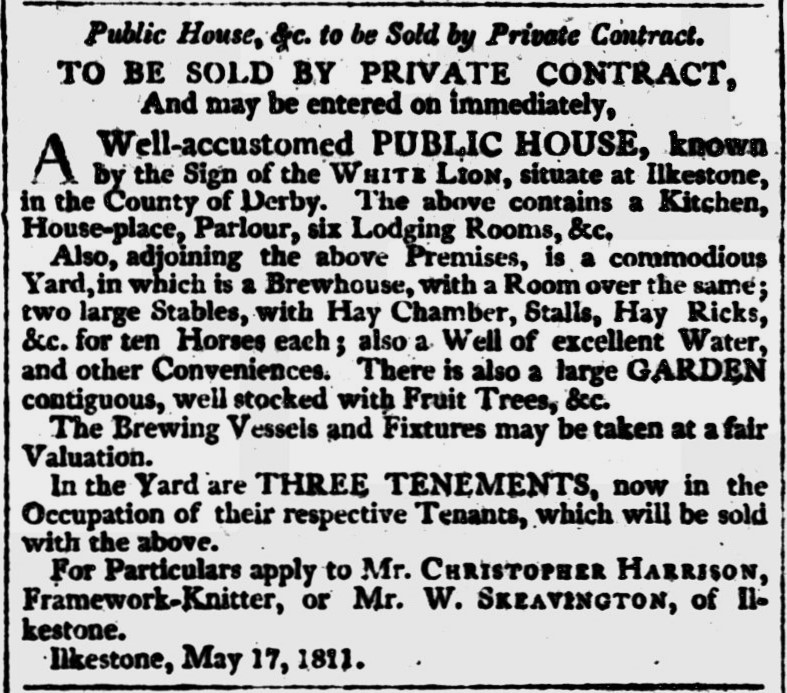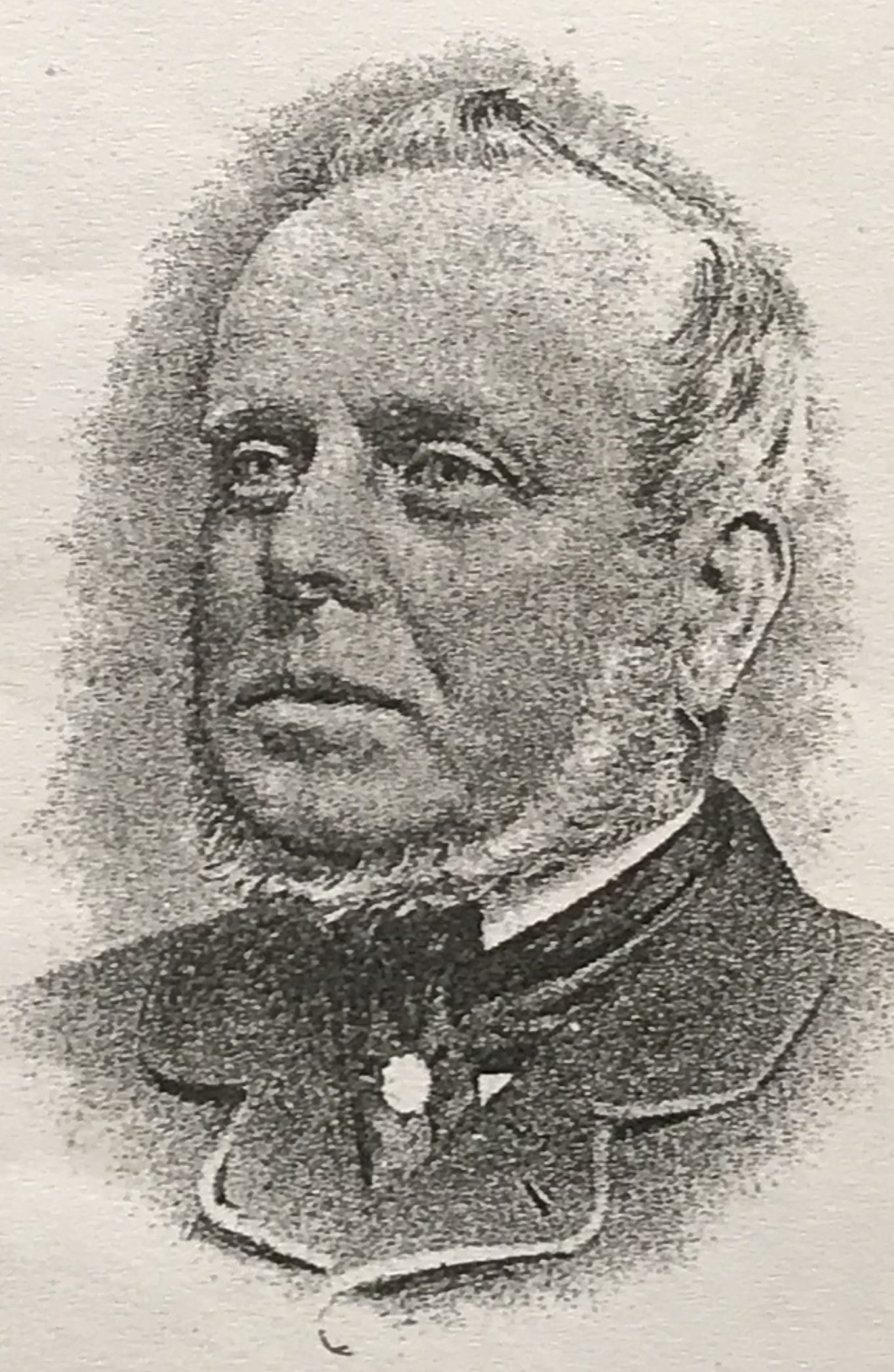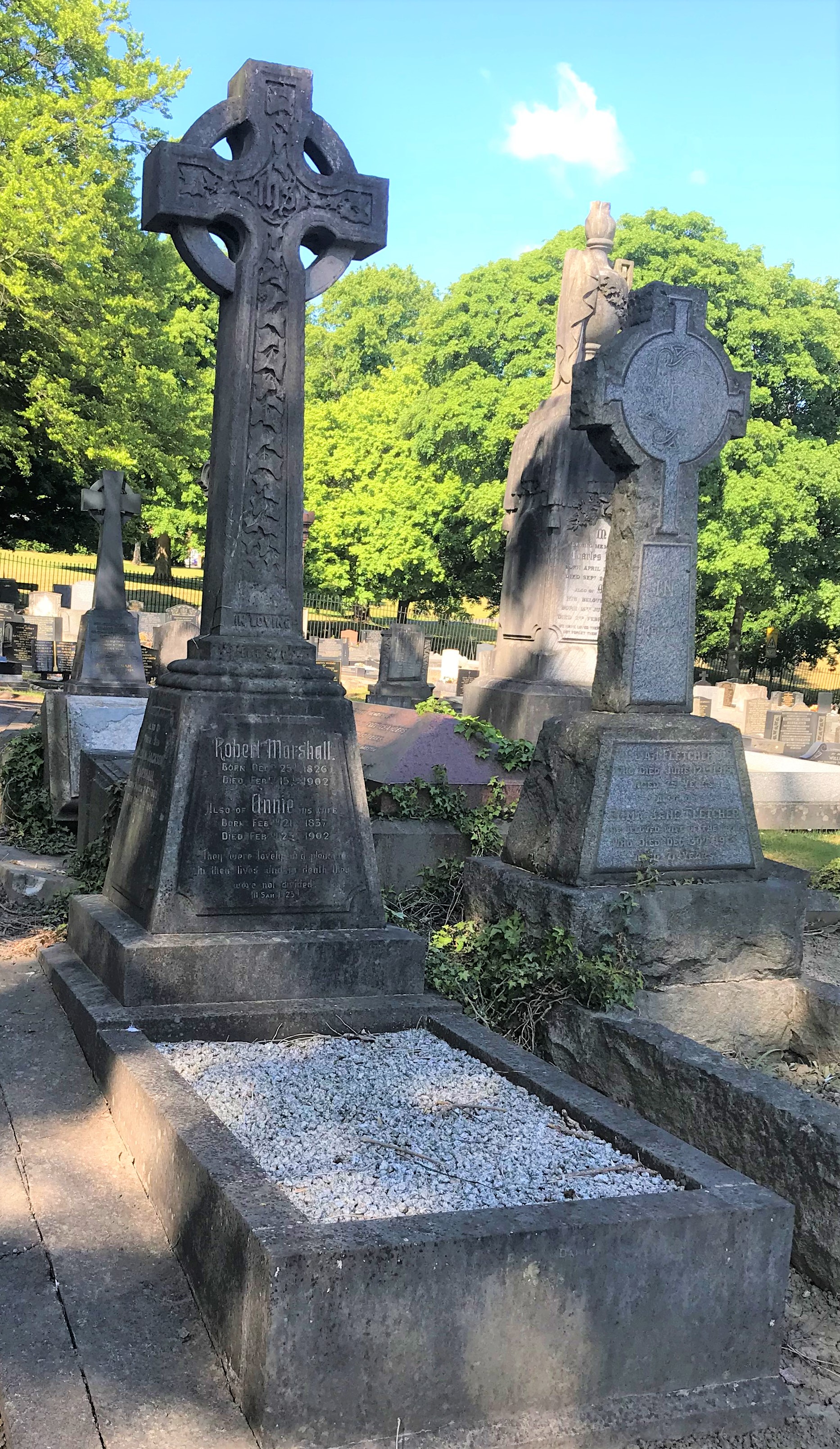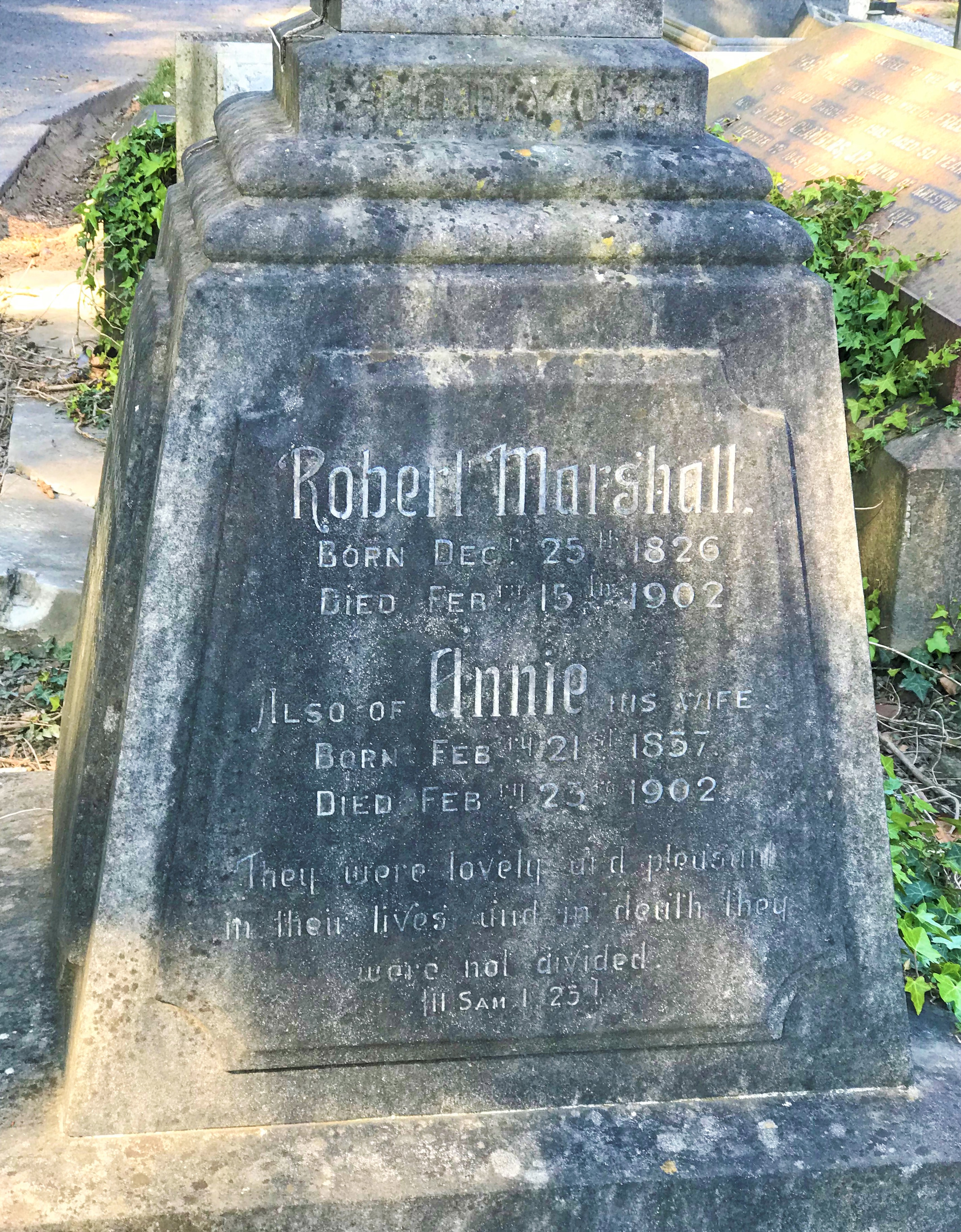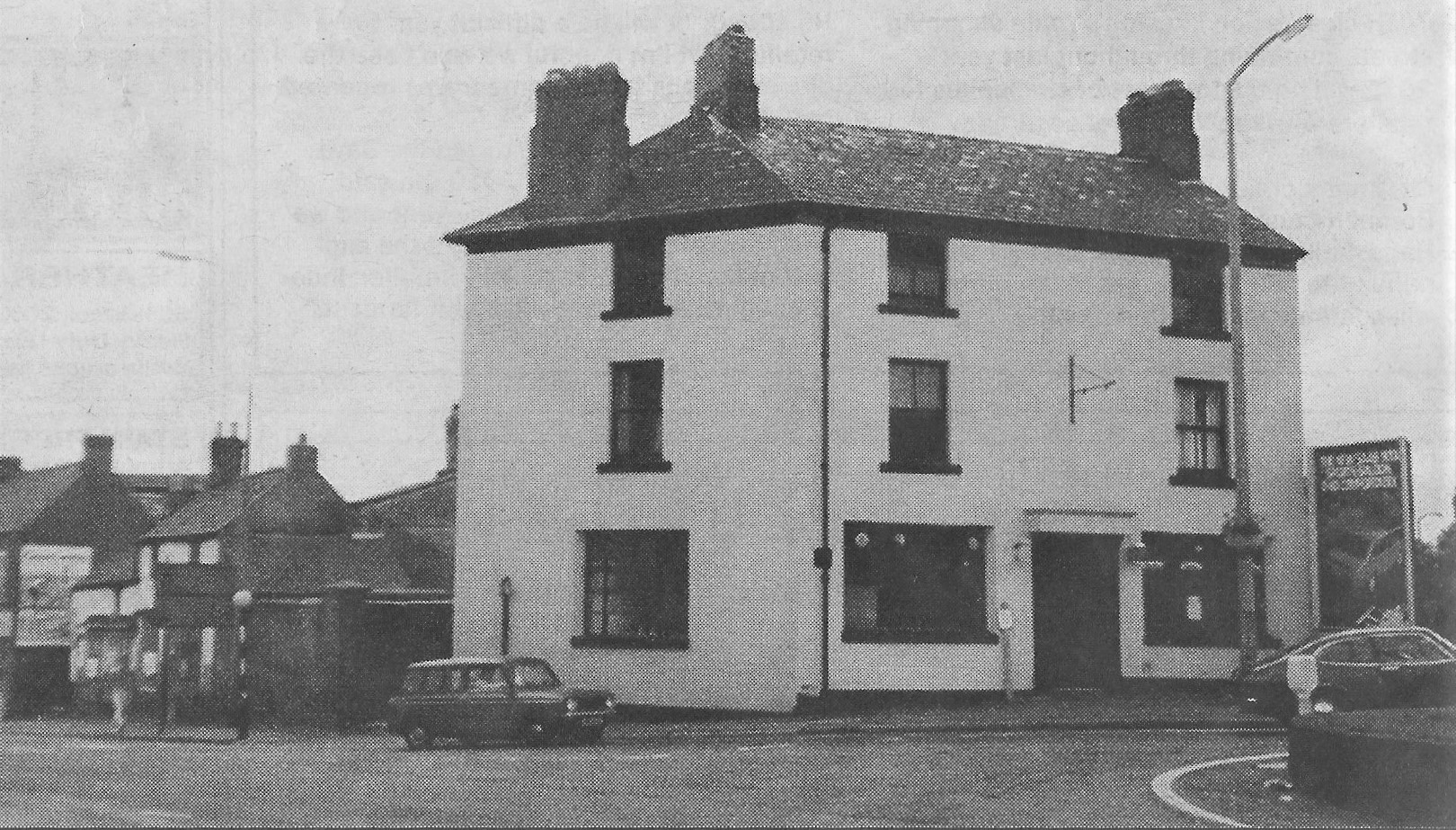We are now walking into the White Lion area of Nottingham Road and on the corner we find another drinking place.
From Cresswell’s Nottingham Journal, October 15th 1763
The Inn is later mentioned in the will of Henry Skevington who died on September 2nd 1807, and is described as part of his estate, “known by the Sign of the White Lion Public House”, in the tenure of his second son Robert. In his will Henry left it, equally, to his three daughters; Ann, who had married hosier Christopher ‘Kester’ Harrison in 1804; unmarried Catherine and Elizabeth, both of whom were subsequently to marry. (Edgar Waterhouse reminds us that the Inn was previously known as the White Hart as well as Ye Fighting Cocks).
For Sale
Nottingham Journal (May 18th, 1811)
———————————————————————————————————————————————-
The Wilson Family at the White Lion
On September 6th, 1821, in the Nottingham Journal, the White Lion Inn was advertised for sale, with an adjoining tenement, all premises occupied by James Wilson. And “the White Lion Inn was kept by Mr. Wilson” recalls Adeline.
Before Robert Marshall’s tenure (see below), the Inn was kept for many years by the Wilson family.
Adeline would not remember landlord — and watchmaker — James Wilson who died in April 1849, — over five years before she was born — though he is still listed as landlord in Slater’s Directory of 1850 – it had gone to publication before his death?
James’s wife, Calverton-born Mary (nee Lee, the daughter of Bartholomew and Ann), took over as proprietor after his death and is recorded as such on the 1851 census.
Mary died in April 1864, aged 87.
Adeline may be recalling their son, Bartholomew Wilson, (born in 1812) as the landlord.
At his death in 1884 the Pioneer recorded that Bartholomew had been employed as a clerk at Shipley Colliery for many years before succeeding his father as landlord of the White Lion Inn and the Post Office Directory of 1855 lists him as the landlord of that inn.
Bartholomew was also there in April 1857 when he confronted Martin Macarty who was trying to pay for his ale with a counterfeit half-crown. When Bartholomew protested, Martin was affronted and struck the landlord in the face, an action which found him at the County Hall in Derby less than a week later and faced with the choice of a 14s fine or 14 days imprisonment.
Bartholomew was ‘an active promoter of the Gas and Water Companies of Ilkeston’ and in the mid-1850’s began his employment there, his role being variously described as secretary, manager, clerk, agent and treasurer.
In the early 1860’s he moved out of the Inn and into Grange Wood Villa at the top of Nottingham Road where he died in August 1884, aged 71.
———————————————————————————————————————————————-
The Marshall Family at the White Lion
“… and afterwards by Mr. Robert Marshall”. … the Inn’s address then being 112 Nottingham Road in 1871.
Born on Christmas day 1826, Robert Marshall was the youngest son of Market Place grocer Thomas and Catherine (nee Jackson).
After being educated in West Hallam, he was apprenticed to Radford miller George Harrison, who was married to his aunt Lydia (nee Jackson) but this trade didn’t capture his interest. A second, more successful, apprenticeship followed, with butcher Isaac Potter of Smalley before Robert set up on his own butcher’s shop in the Market Place in 1849, sharing a premises with brother Woolstan, a grocer.
In August 1858 Robert married Ann Bentley, daughter of William, erstwhile publican at the Moon and Stars Inn at Eastwood and later farmer of Purdy House farm in Shipley, and Ann (nee Buxton). The bride was several months pregnant but the subsequent son, William Thomas, survived only two weeks.
The couple had at least 13 other children, seven of them alive at the time of their father’s death in 1902… William Jackson, John, Anna Joanna Jackson, Walls, Lydia, Mary Ellen and Robert junior.
In 1862 Robert became landlord of the White Lion Inn, a position he held for 23 years when he retired.
In 1873 Robert successfully applied for an extension of opening hours for Christmas Eve as he was hosting a private party.
In June 1883 the Inn (copyhold) was sold to Mr (William?) Tatham farmer of Papplewick for £2250. His son Joseph then occupied itas landlord until it was put up for sale in April 1888 (freehold), along with two adjacent dwelling houses, fronting Nottingham Road. The premises were not sold however, though in June 1888 the licence was transferred from William Tatham to William Pounder.
———————————————————————————————————————————————-
After retirement the Marshall family lived for a time in White Lion Square before moving into Oakwell Farm about 1896.
In 1902 the Pioneer noted that “Mr. Marshall’s tall and erect form was familiar to most Ilkestonians; while his quiet and unassuming demeanour gained for him the respect and esteem of all classes of the community …. A Church of England member and inclined towards Conservatism, though a reluctant participant in political or local affairs”, a reluctance which the Advertiser tried to explain.
“He was too great a lover of peace and amity with all grades of society to publicly identify himself with any political party”.
However he did serve on the Local Board and filled ‘the comparatively obscure office’ of Overseer for the Poor.
The Pioneer thought him a thorough businessman whose “strict integrity which always characterised his dealings won for him a reputation which was highly creditable’”.
In February 1902, a slight cold preceded a more serious attack of bronchitis and then pleurisy, and within a week Robert was dead — on February 15th — at his Oakwell farm home.
Robert was buried at Park Cemetery on February 18th.
Eight days later the mourners were gathered around the same grave, this time to bury Robert‘s wife.
Ann had been severely affected by the death of her husband; ‘shock, grief which could find no relief and a broken heart contributing to the sad finale’.
The Celtic or Irish cross, taking the form of a cross within a circle, generally represents eternity.
———————————————————————————————————————————————-
The Inn in the 1980s … Nottingham Road is on the left
———————————————————————————————————————————————-
Before we move on — thanks to Jim Morse, there is a section on Bartolomew Wilson and his family we can now examine


